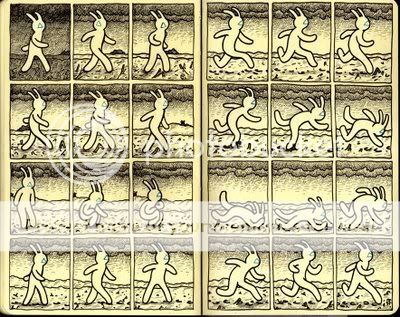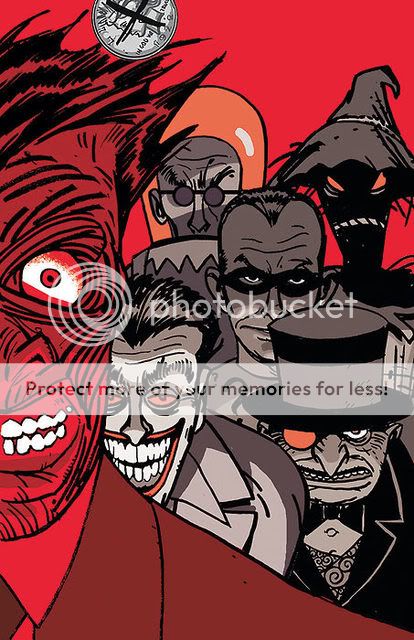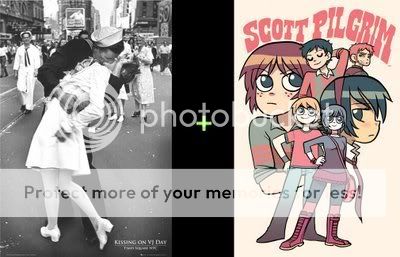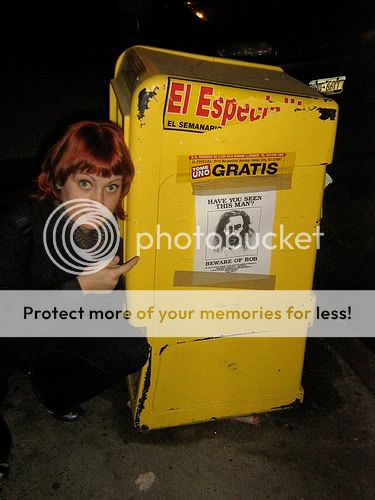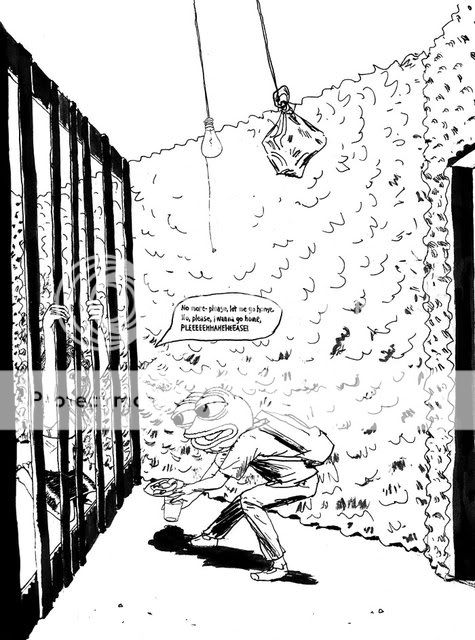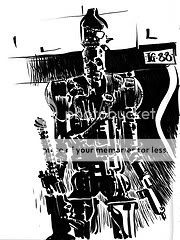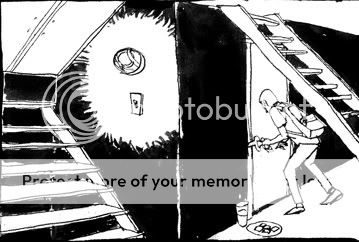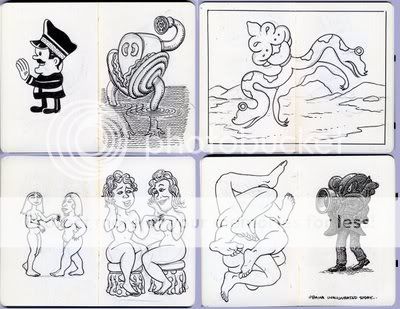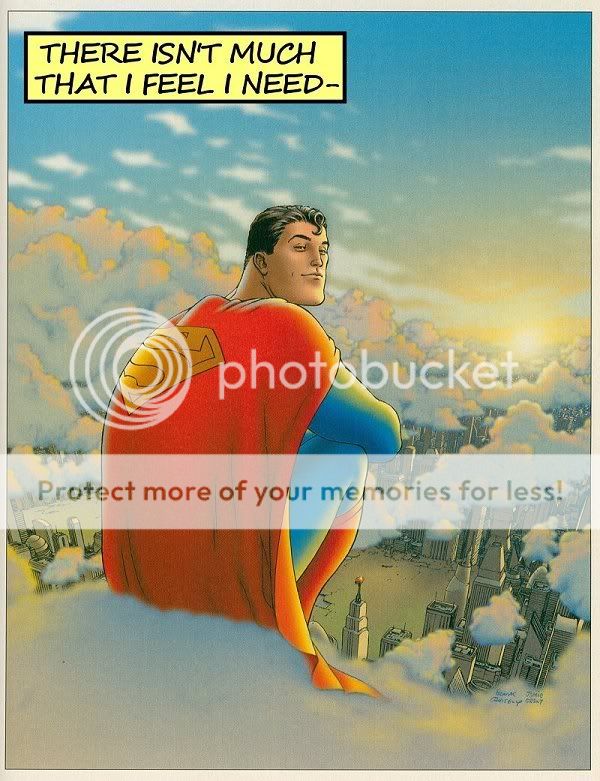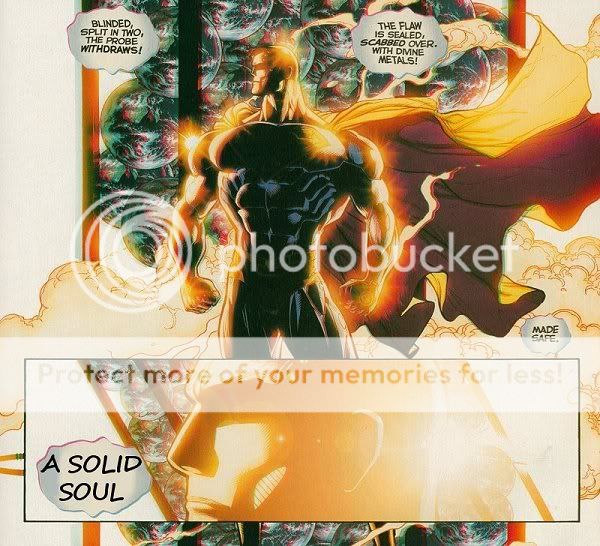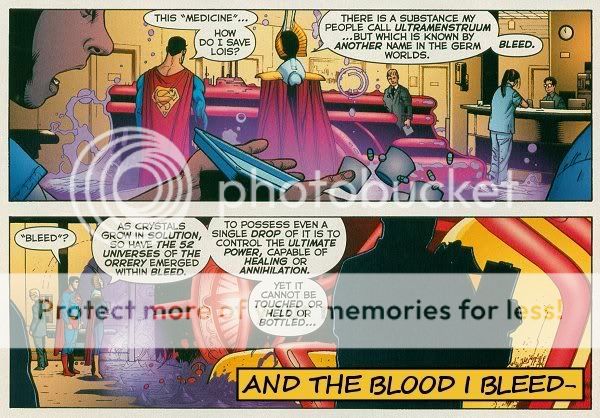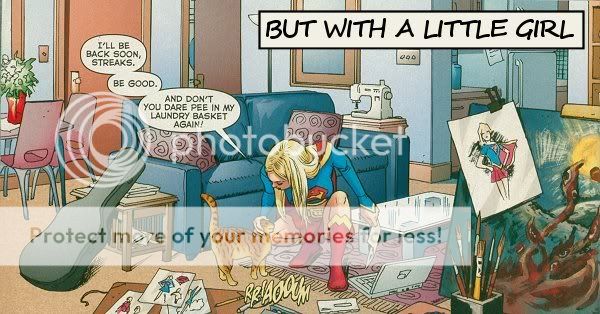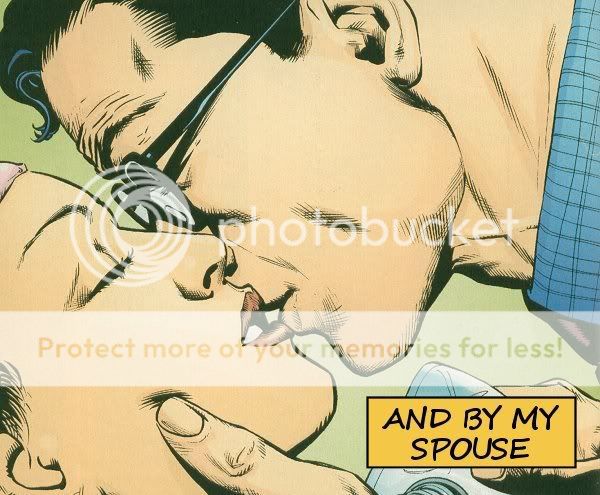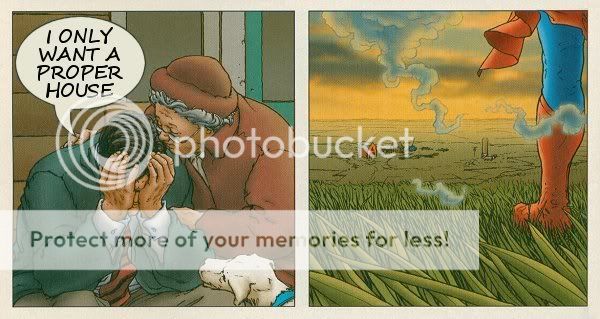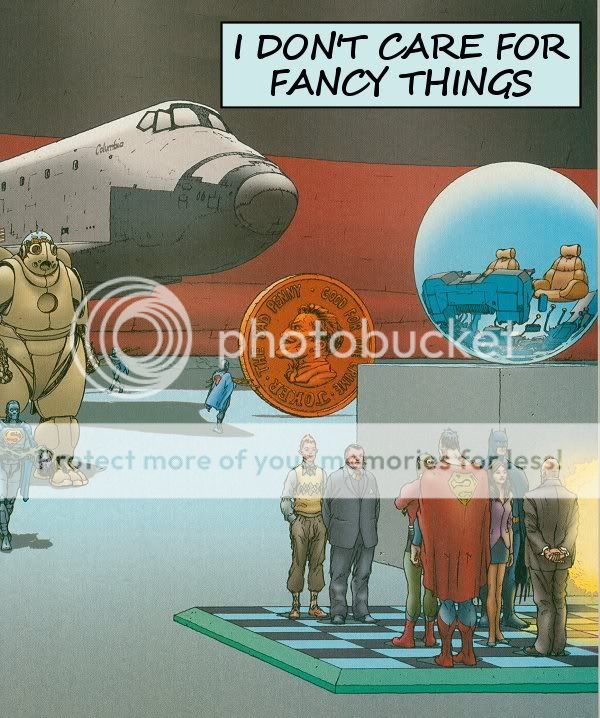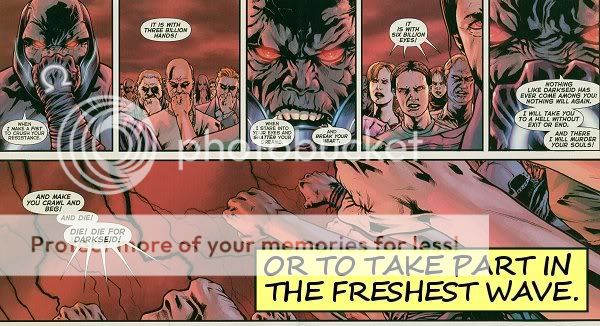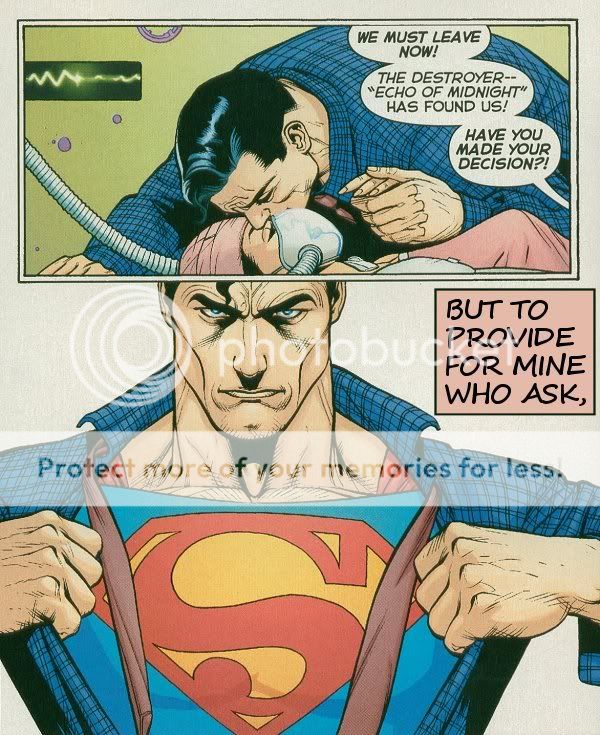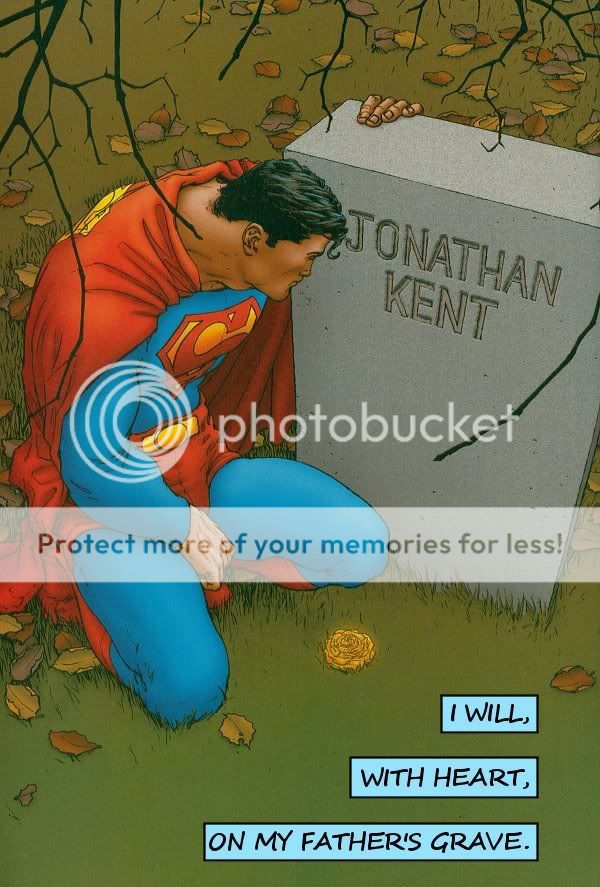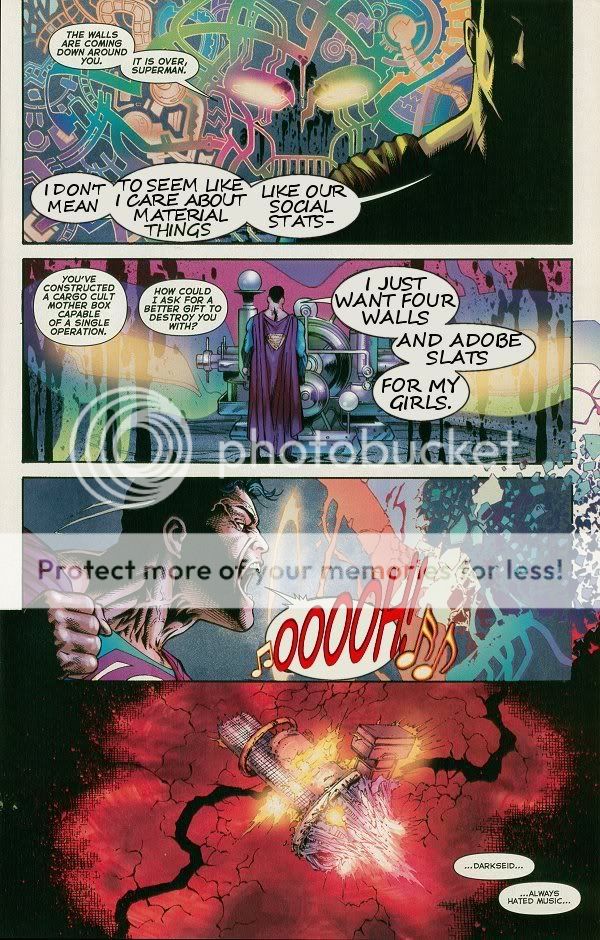![]() Fans of my David Bowie sketchbook galleries would be well advised to check out my introductory post at the Savage Critics.
Fans of my David Bowie sketchbook galleries would be well advised to check out my introductory post at the Savage Critics.
What kind of magic spell to use?
Carnival of souls
* Now it can be told: I’ve joined the Savage Critics! I’m part of a wave of new members that includes Tucker Stone, Dick Hyacinth, David Uzumeri, and Chris Eckert. Should be a pip. Thanks to Brian Hibbs for the opportunity!
* ShockTillYouDrop.com has been speaking to Clive Barker about Hellraiser remake helmer Pascal “Martyrs” Laugier, potential Pinhead redesigns, abandoned plans for a Midnight Meat Train film trilogy, a Hellraiser spanking the censors didn’t want you to see, and more.
* Josh Cotter: killin’ it.
Battlestar Galactica thoughts
SPOILERS SPOILERS
* Infodump! I thought it was pretty elegantly done for all that, though, because they couched it in compelling material. With Ellen, you had her panic and confusion and desperation upon waking up in the Cylon ship, rapidly replaced by an entirely new personality for that character–the real personality for that character, as it turns out. The frisson of this material, plus getting to see her duke it out intellectually with that candy-colored clown they call the sandman, Dean Stockwell, gave her and Cavil’s part of the infodump some real charge.
* It did feel a bit like Anders’s gunshot-driven revelations could have been better conveyed over a longer period of time, or visually rather than verbally. But I also understand what the show’s temporal and financial limitations are at this point, and once they waited this long their choices were few. As I’ve said a million times, I’m here for the human drama more than I’m here for some complex mythology–after all, when you start watching BSG, the complex mythology doesn’t even exist!–so all things considered I’m really glad they’ve spent this half-season dealing with things like the coup than with mysterious flashbacks to the earth-Cylons’ past or what have you. In a way, they tried to bridge that gap in the Anders segments, having his revelations come as a direct result of the wounds he incurred during the coup, and making the main conflict in his half of the episode be “Starbuck and the Cylons want to find out what the hell’s going on” vs. “Starbuck wants to help the man she loves.” Heh, that’s the main schism of Battlestar Galactica fandom in a nutshell!
* I think the best sign of the success of the infodumps here is that my two favorite BSG bloggers, Todd VanDerWerff and Jim Henley, each preferred a different one of the two approaches.
* VanDerWerff also accurately notes that we fans have wanted to know this information for so long that his episode had a lot of goodwill to coast on in order to reach its goal. Even though the mythology isn’t necessarily my thing, I can certainly confirm that–I was just so excited to hear the story come together in a way that made sense and had some emotional and thematic heft to it that they practically could have gotten away with having a character sit in front of the camera reading it from a book.
* Part of me is a little iffy about the idea that the Cylon nuclear holocaust wasn’t really all the humans’ fault in that they built the Cylons. I know you can trace it back thousands of years or whatever, but I’m with Tigh–the Five Cylons are to blame for the depredations of the Seven Known Models at least as much as humankind is, and I’m bummed about that. You lose some of that Frankenstein’s monster mojo if that’s the case.
* The rot in the bones of the Galactica is maybe the show’s most obvious metaphor to date, but this is the time in the series for obvious metaphors as far as I’m concerned.
Comics Time: Sulk Vol. 1: Bighead & Friends
Sulk Vol. 1: Bighead & Friends
Jeffrey Brown, writer/artist
Top Shelf, September 2008
64 pages
$7
For all its lo-fi provenance, Jeffrey Brown’s art has always felt rounded and tactile and full to me. His figures may have the disproportionately large heads and bendy arms of doodled cartoons, but they move around in environments you feel like you could swing through the panel into and explore; seeing one of his gridlike pages is like being presented with an array of tiny windows that way. Meanwhile there’s an emphasis on shading that reinforces the palpability of what he’s drawing. There really isn’t anything else, including (or perhaps especially) all the young cartoonists you see upon whom Brown is an obvious influence, that looks like it. It works a lot differently than, say, David Heatley’s stuff, despite the surface similarities you’d find between two guys who do lo-fi autobio comics with lots of little panels.
Bighead isn’t autobio, there aren’t a lot of little panels, and it’s only barely lo-fi, but all of the above still stands. In the past, this kind of parody work is the closest Brown has come to really showing off his chops, and that trend continues. All those penstroke shading lines frequently accrue into something rather lovely–the robotic arms of the Claw’s deathtrap, the darkness of “one of Chicago’s famous ‘indie rock’ shows,” the vortext that swallows the Author when he messes with reality a little too much.
Meanwhile the superhero parody gags made me laugh repeatedly, particularly the dialogue. Brown really nails overwrought, superhero house-style banter that makes it seem like its author doesn’t quite understand how to write. “This time you’ve gone too far, The Claw!” “I’m crazy? I’m crazy?! Don’t you know who you’re talking to? You’re talking to me!” There are equally effective sight gags, from the Superboy-like Little Bighead getting so emotional about the Pacifier’s rampage that he finally just breaks down and starts sucking on the vigilante’s rubber-nipple headgear to the opening splash page of Bighead crashing through a window with a caption reading “HOLY SHIT!” And then there’s the tragic tale of Beefy Hipster, driven to supercrime by his inability to fit into his favorite band’s American Peril t-shirts.
It’s a funny, intelligently drawn superhero humor comic, and usually you can only get one or the other, if anything, so if you want to laugh at superhero comics that actually are intriguing to look at, by all means check this out.
Lost thoughts
SPOILER SECURITY DEVICE
* This has already come up this season, but it bears repeating: It’s a lot tougher for the show to do “shapeless dread” now that we’ve met all the Others, and gotten a good look at the Smoke Monster, and learned that the Dharma Initiative was ultimately a bit on the ineffectual side, and discovered that it’s all part of some great game between Ben Linus and a British tycoon, and so on and so forth, than it was back in Season One when you had no idea what the fuck was going on. So this episode was an all-out effort to, in the words of “The Battle of Evermore,” bring it back. Smoke monster attacks, crazy Rousseau, “the sickness” turning out not to be the time-travel aneurysms at all, brainwashed Frenchmen, Christian/Jacob, the freaking Temple at long last, “This place is death!“…the aim was to freak you out with mystery and terror. It worked pretty well. It still wasn’t as scary as the show used to be (remember the hieroglyphics on the countdown clock, or when the pilot got snatched out of the plane, or “we’re gonna have to take the boy,” or “help…me…”)?–but maybe we’ll get there this season if and when Jacob starts playing a bigger role.
* In the latest of his unceasingly excellent weekly Lost reviews, Todd VanDerWerff points out that the absence of flashbacks and flashforwards removes some of the intra-episode narrative coherence from how the show tells its story. Instead of having a subplot with a beginning, middle, and ending within the hour even as the larger Island plot rolls on, now it’s all plot, which (as I said of the premiere) gives the episodes a slightly overstuffed feel at times. But the pace is so breakneck, and the movement toward a destination seemingly so assured, that it’s still really satisfying, I think.
* Gory, wasn’t it? Bone shards, fly-ridden corpses, dismembered arms–it was the Geoff Johns episode of Lost. Good for them! Lost at its best is full of pulp thrills.
* This is probably an awful thing to say, but I never found Rebecca “Charlotte” Mader attractive until she went nuts and started dying. Those crazy-eyes! Hubba hubba.
* You know what? I think that’s an okay thing to say. The attractiveness of its leads is a big part of Lost’s appeal, and not just for dudes–it’s the one show I can think of where female fans seem to be randier for the male cast than male fans are for the female cast. But seriously: Evangeline Lily, Elizabeth Mitchell, Emilie De Ravin, Maggie Grace, Yunjin Kim, Michelle Rodriguez, Cynthia Watros, Sonya Walger? Damn. See what I mean? Pulp thrills.
* I chuckled at how in-your-face that cliffhanger ending was.
Carnival of souls
* Cold Heat has a blog? And Frank Santoro and BJ are doing something in Mome? Hot cha!
* So, looks like They might have approached the Wachowski Brothers about directing a Superman reboot trilogy. I can’t imagine that Warner Bros. is in a “let’s put a franchise in the hands of the Wachwoskis” mood after Speed Racer and The Matrix Revolutions, so in general I echo Rob Bricken’s call for calm, but for now I’ll play along because there’s a possibility this could end up being really cool. Speed Racer would be a terrific direction for a more science-fiction/fighting with Brainiac, Bizarro, and Darkseid Superman movie to go in visually, while the aerial battle between Neo and Smith at the end of the third Matrix flick was already the best Superman fight scene ever filmed.
* David Cronenberg directing Tom Cruise and Denzel Washington in a Robert Ludlum adaptation? Sure, I’ll eat it.
* The Descent 2 trailer was up but is no longer. Oh well.
* I liked Dash Shaw’s Best Comics of 2008 list.
* Speaking of Dash, he’s finished Body World, which gives me a decent excuse to read it from start to finish.
* Something about this sentence cracked me up: “Like so many bloggers, I was a big fan of Jim Rugg and Brian Maruca’s 2004 series Street Angel.” Like so many bloggers and so few readers, alas. But it was a great comic and the short live-action film version of it looks pretty great.
* Eve Tushnet waxes enthusiastic about the Brian Michael Bendis/Michael Gaydos Alias reunion.
* Bruce Campbell says no to Evil Dead IV. This comes several years after I said no to Evil Dead IV.
* Finally, like everyone else on the comics Internet, I bow before the almighty majesty of Alvin Buenaventura’s star-studded Angouleme Festival flickr set.
Seeing R. Crumb, Chris Ware, and Dan Clowes in the same picture makes my Bowie sketchbook ache. (Can you imagine how Crumb would react if I asked him for a drawing of Ziggy Stardust?)
Carnival of souls
* This sort of thing tickles me pink: Political bloggers Jonah Goldberg, Robert Farley, Spencer Ackerman, Robert Farley again, and Matthew Yglesias discuss recent developments in the world of Battlestar Galactica. There’s something really funny about people who normally write about the Middle East policy or the stimulus package addressing in-world politics like dudes in the Android’s Dungeon on New Comics Day arguing over whether or not Wolverine would really say that. The second Farley post in particular is gloriously nerdy in that regard. Also, this reminds me that I have a theory regarding the changes in behavior amongst the Cylons that I need to explore here on the blog at some point.
* For me, the appeal of a second Hobbit movie that fleshes out the stuff going on off-page during and after Bilbo Baggins’s journey There and Back Again centered largely on the image of the White Council–Saruman, Gandalf, Radagast, Galadriel, Celeborn, Elrond, and Cirdan, if I’m not mistaken–pulling a Magnificent Seven and kicking Sauron (then still known as the Necromancer) out of his Mirkwood stronghold, Dol Guldur, which is what Gandalf was busy doing for much of the time Bilbo and the Dwarves were mucking about with the Elves, the Lakemen, and Smaug iirc. With that in mind it’s a bummer to hear Christopher “Saruman” Lee say that his advanced age would probably prevent him from traveling to New Zealand to take part in the filming, should his character be required. I’m sure he’d like to portray Saruman’s last act of benevolence just as much as I’d like to see him do so. Still, maybe they could film him in London, as the interviewer suggests? (Via The One Ring.)
* Hey, it’s the teaser trailer for Quentin Tarantino’s Inglourious Basterds. Yay, war crimes! (Via AICN.)
* Kiel Phegley talks to Ed Brubaker about that “Marvels Project” thing I mentioned the other day. Sounds like Bru and artist Steve Epting will more or less be doing exactly what they did with Captain America, only telling the full story of Cap and the Invaders back in the past. Sign me up.
* Becky Cloonan says that Tokyopop is more or less sitting on East Coast Rising Vol. 2. Travesty.
* Eric Reynolds laments Reed’s move to make Book Expo America a permanent NYC fixture, since that’s hella inconvenient and expensive for non-NYC-based (read: non-corporate) publishers.
* Back when I was at Wizard, one of my favorite tasks was helping to assemble a publication called PosterMania, which was nothing more or less than a collection of pullout poster versions of various covers and occasionally splash pages from various publishers. Comic Books! is essentially the exact same thing in tumblr form. Its taste and mine don’t line up perfectly, and it’s virtually all Big Two stuff, but frankly there are a lot of cool covers from those companies around, so this was quite a find for me. I’d imagine there are plenty of people reading this blog who would be perfectly happy if there only interaction with these properties were things like this Mark Chiarello Two-Face: Year One cover, for example. (Via Sean B.)
* Ladies and gentlemen, in honor of his uncredited cameo as General Zod in this week’s Pablo Raimondi-illustrated issue of Action Comics, a young Ian McShane. Break open the fuckin’ canned peaches indeed.
* Glenn Greenwald and Spencer Ackerman follow up on disturbing recent moves by the Obama administration regarding state secrets & extraordinary rendition and indefinite detention respectively.
* Finally, I support this idea of Heidi MacDonald’s:
* Fist bumping should replace handshakes as the official con greeting to slow spread of Con SARS.
Comics Time: Scott Pilgrim Vol. 5: Scott Pilgrim vs. the Universe
Scott Pilgrim Vol. 5: Scott Pilgrim vs. the Universe
Bryan Lee O’Malley, writer/artist
Oni Press, February 2009
192 pages
$11.95
The greatest trick Scott Pilgrim ever pulled was convincing you its conscience didn’t exist. For a long time, the series’ skeptics criticized the shortcomings of the characters as though their existence was a shortcoming of their creator–as though writer/artist O’Malley was unaware that Scott was kind of shiftless and feckless, or that Ramona Flowers was a little bit cruel and aloof, or that their group of friends was cliquey and catty. I definitely see where such critics are coming from, for a couple of reasons: first, that was pretty much my line of attack when I first read Jaime Hernandez’s Locas material (newsflash: Hopey’s a jerk and Maggie’s a mess!); second, I am now a 30-year-old married homeowner in Levittown, and the further I get from Scott’s situation, the harder it gets to relate to, or even in some ways really care about, his plight.
But over the past three volumes, O’Malley has slowly pulled back the operating curtain to reveal the beating heart of the series; if you’ll allow me to mix metaphors, what this means is that the chickens have been coming home to roost. It turns out that all those evil ex-boyfriends aren’t just plot devices, but people who’ve had a lasting effect on how Ramona lives. It turns out that Scott’s glibness both hurts his relationship(s) and enables him to see their potential when others can no longer do so. It turns out that Knives’s lasting crush on Scott isn’t just a funny recurring gag, but something that’s screwing up her life and causing her to screw up the lives of those around her. It turns out that all the “we suck”isms the band indulges in actually have power in a self-fulfilling prophecy kind of way. It turns out that supporting players have lives of their own and that they can really grow to dislike how oblivious the main characters are to that fact. And so on and so forth.
At the risk of saying what I say any time a new Scott Pilgrim comes out, the singular achievement of the series is conveying all this stuff through the visual language of video games, action comics, and shonen manga. By all means, let the evil ex-boyfriends whose attack finally splits up Scott and Ramona be Japanese hipster versions of Tomax and Xamot, the creepy Crimson Twins from G.I. Joe. Let the fact that Scott is going to have a very rough time in this volume be foreshadowed by not collecting any loot when he defeats a tiny robot at a party. Let the whole emotional tone of the book be telegraphed in a pair of anecdotes about ’80s Chris Claremont X-Men storylines. Let trying to figure out Ramona’s big secret be represented by having her inexplicably glow every once in a while–and then let that be conveyed in part through having a foil cover!
I’m not trying to make the case that Scott Pilgrim fleshes out its characters or connects emotionally the way a good Clowes or Burns or Tomine graphic novel about young people trying to form and maintain relationships does, or that addressing such people is completely unprecedented. It doesn’t and it obviously isn’t. It’s still as much or more about screwball comedy and banter and clever visual elements as all that. But it’s a really fun book, and a lovely-looking book, and ultimately, surprisingly, a complex book. Pretty sneaky, Scott.
Carnival of souls
* Austin English interviews Theo Ellsworth, author of Capacity, one of the very best comics of 2008. Dude draws 10-13 hours a day!
* Todd VanDerWerrf’s latest Battlestar Galactica review is must reading as always.
* Chris Butcher adds a little bit to his earlier thoughts on Diamond raising its order minimums, mainly regarding the notion that a cratering market forced Diamond’s hand on the move.
* Rickey Purdin presents a con report featuring pix of sketches, loot, panels, thank-yous, the usual fun con-report stuff.
* They’re fucking arresting people in the Michael Phelps “case.” This is Drug War madness at its absolute maddest. Arresting eight people because the greatest Olympic athlete of all time hit a bong! I guess he’s a huge threat to society, huh? At any rate, pleasure must be prosecuted at all costs. Fucking Anti-Life. (Via Andrew Sullivan.)
* Finally, videogame characters that look like David Bowie. (Hat tip: Ryan “Agent M” Penagos.)
Battlestar Galactica thoughts
SPOILER TIME
* I really, really enjoyed this storyline. Like I’ve said, I was hoping that the discovery of Earth would really reveal major cracks in what’s left of the humans’ civil society, and this sort of thing was exactly what I meant. Zarek had been a terrorist long ago, but in this episode he seemed to be showing a level of barbarity that surprised even him–that’s the kind of thing I’m talking about. It’s what I want from Battlestar Galactica.
* I don’t get the notion–which to be fair I’ve only seen expressed by other people who don’t get it–that the storyline is pointless and that the resolution we saw last night represents a return to the status quo ante. If Battlestar Galactica does anything well it’s showing how long-lasting the consequences of old storylines can be–I mean, half of the lead mutineers here were Pegasus refugees, Gaeta’s motivations can be traced back to New Caprica, and his relationship with Baltar is one of the oldest, if quietest, running gags on the show. I can’t imagine that at this stage in the game, a briefly successful coup that resulted in the death of virtually the entire government except a President who is herself dying is going to get swept under the rug.
* I like when the show does action and gives its action heroes action hero stuff to do, so seeing Starbuck and Apollo run around with guns like the old days was a real treat.
* On a related note, even though I wish the commercials hadn’t spoiled this for weeks, Roslin completely going nuts gave me chills like crazy. It was very very clever of Mary McDonnell to riff on Hillary Clinton’s trademark strident vocal pitch, but the way it seemed to vomit out of her, as opposed to Clinton’s rather robotic rallying cries, was really frightening. A great, show-defining moment.
* You know one thing that does bother me about the show? It’s never ever fleshed out the marines, or made them anything other than thugs. It’s a weird dropped ball.
* Attention to detail alert: the little puddles of water and urine beneath the urinals.
* Attention to Freud alert: Starbuck braining a dude as he’s draining the lizard.
* The scene between Baltar and Gaeta was one of my favorites in the entire history of the show. It gave James Callis more to do than he’s had to do in the season so far. It followed up on a long-established relationship that hadn’t been at the fore of the show in a long long time, which is the sort of thing I always appreciate in long-running serialized dramas. It was probably Alessandro Juliani’s finest few moments as an actor. I think there was something moving about how these two have sinned against so many people, and each other, and yet in that brief moment managed to forgive themselves and each other and take comfort in one another. As a Deadwood fan, I’m a sucker for when grown men cry because they love each other.
* Maybe even more moving? Zarek managing a smile for Felix, and Felix smiling back. They’re human, after all. Somehow, showing that made the show simultaneously more uplifting and more depressing. And again, that’s what I want from Battlestar Galactica.
* I suppose that if you held a gun to my head I’d have to tell you I thought that the itch in Gaeta’s stump going away right before he gets executed was a little much, but only if you held a gun to my head.
* I know people didn’t like the Chief’s tunnel-crawling, but I thought the endless nature of it all just showed how far he was willing to go for this. It helps that Aaron Douglas is sort of the heart of the show–it fits that his Chief saved the day.
* Ending the arc with the Chief discovering literal cracks in the heart of Galactica herself–well, that’s no accident.
Carnival of souls
* Plugs 4 Pals part one: Ben Morse will be editing War of Kings: Warriors, a digital comic tying in with Marvel’s space-opera event. Ben knows from Marvel’s space stuff, so if you’re interested in that sort of thing at all, you’d be wise to check it out.
* Plugs 4 Pals part two: Justin Aclin has launched a new blog to promote Hero House, his superhero graphic novel, due from Avatar in September. Justin knows from superhero comedy, so if you’re interested in that sort of thing at all, you’d be wise to check it out.
* Tom Spurgeon explains “why Diamond’s new minimums policy is wrong, and what they should do about it.” Like some other recent efforts of that sort, it recognizes the need to square the circle between what one assumes are Diamond’s concerns about getting weighted down with unprofessional product and the rest of the industry’s concerns about Diamond’s judgement in determining what constitutes “unprofessional product.” It also unpacks several business and financial assertions made by and on behalf of Diamond that don’t hold much water upon closer examination.
* Speaking of Spurge, in a comment downblog he corrects my mischaracterization of his position regarding Final Crisis and the big superheroes in general: It’s not that he thinks they have “no juice left at all to thrill or inspire or encourage,” but that Final Crisis would have been a better book had Morrison addressed that question head on rather than taking it as a given. And he’s right, you really don’t see Morrison questioning his own beliefs in his work all that often. They’re more an articulation of those beliefs, in fact; from interviews I’ve both read and conducted with Morrison, though, I do get the sense that a lot of his darker books arise from unrelated, IRL personal problems he’s had. In this case, the implication appears to be that the notion of drab, uninspiring superheroes is one he’s confronted behind the scenes rather than on the page.
* Tom also notes, both in that comment and in his original review, that Morrisonian victories just sort of happen. I see what he’s saying–the heroes win due to inherent qualities present within them all along rather than using some newly acquired internal strengths to effect their peripeteia (note: I’d been using that word incorrectly for about a decade so I’m breaking it out now that I know that it means “reversal of fortune”)–but it still seems kosher to me since it usually takes them a lot of blood, sweat, and tears until they’re in a position where they have the confidence, know-how, or freedom to act in this way. It’s a lot different than the work of former Morrison protege Mark Millar, wherein the protagonists always just start winning because it’s the point in the narrative where that’s supposed to happen, and there really wasn’t anything stopping them from winning before then aside from Millar’s rudimentary knowledge of Robert McKee.
* NYCC news, Brian Michael Bendis division, part four: There’s a new Michael Gaydos-drawn Alias miniseries on the way. (Good catch, Kevin Melrose.)
* NYCC news: Ed Brubaker and his Captain America collaborator Steve Epting are working on something called The Marvels Project, “which explores the origins of the Marvel Universe” and launches in June according to the meager info at the link. Anyone got more substantial stuff on that?
* NYCC news: Lockjaw and the Pet Avengers? I dunno if I’ll eat it, but I’ll think it’s a terrific idea for an image, that’s for sure. Wouldn’t it be rad if it were actually about animal rights in some semi-serious way? I’ll be over here holding my breath.
* Two new series from Naoki Urasawa debut today: Pluto and 20th Century Boys. I’m curious.
* So that’s what Mat Brinkman looks like. It’s kind of a bummer that we’ve lost him to the fine art world the way we lost Dave Cooper and Marc Bell, huh?
* Lux Interior died. I’m not going to lie and say I was a big Cramps listener, aside from the healthy appreciation held by anyone who came of age in that weird early-mid-’90s period when suddenly any vaguely outsiderish subculture could get purchase in the national media and suddenly psychobilly and other revivals of ’50s trash culture were a visible thing and Beavis and Butt-Head couldn’t get over how awesome the title “Bikini Girls with Machine Guns” was. But one deep-seated belief I always had was that “Lux Interior” is the best, funniest nom de rock invented by anyone ever. And now, after seeing clips of the relevant show here and there around the internet, a belief that the band’s 1978 gig at California’s Napa State Mental Hospital is one of the most inspired and subversive ideas ever had by a rock band is gaining ground fast. I’ve spent a little more time in mental institutions than I ever anticipated or hoped to spend, and there’s this mix of rage and excitement and fear and crazy happiness you feel that is embodied pretty well by sticking a bunch of weirdos in the middle and letting them play down and dirty rock and roll.
* The Obama administration has decided to back the Bush administration’s use of extraordinary rendition as a backdoor to torture by officially declaring its belief that a lawsuit regarding the practice is off limits to the courts due to “state secrets.” The read seems to be that this is more an matter of the new administration attempting to keep the previous administration from being on the receiving end of legal action than with actually continuing the practice itself, but either way it’s scary. Glenn Greenwald has more.
* Finally, if you’ve never heard the story of the life and loves Genesis P-Orridge, coiner of the terms “industrial music” and “acid house” and one of my childhood heroes–particularly the part of the story about how he’s had extensive surgery, including breast implants, to make himself look more like his late wife–this profile of Gen is for you. (Via 33 1/3.)
Comics Time: Cry Yourself to Sleep
Cry Yourself to Sleep
Jeremy Tinder, writer/artist
Top Shelf Productions, 2006
88 pages
$7
Originally written on July 23, 2006 for publication in The Comics Journal
Try to contain your surprise: This book from Top Shelf contains cute, anthropomorphized animals! Gee, I hope you were sitting down. Ah, I kid because I love, of course. And while it is true that Top Shelf has returned to that Chunky Rice sweet spot many a time since Craig Thompson knocked one out of the park with it years ago, Jeremy Tinder’s Cry Yourself to Sleep distinguishes itself by, well, distinguishing itself. It doesn’t go in for the cute-overload of a Spiral-Bound, nor for the tremulous quasi-mysticism of a Pulpatoon Pilgrimage (the AdHouse Books effort that of all post-Chunky “Manimals’ Search for Meaning” books feels most like a Craig Thompson cover band). It mainly sets out to be funny, and quite happily, it succeeds.
It’s a slight volume with a slight plot: Over the course of a couple of days, three pretty much adorable characters intended as stand-ins for the book’s twentysomething target audience–a guy named Andy, a rabbit named Jim, and a robot named The Robot–struggle with three early-life crises–Andy’s novel is rejected by a publisher, Jim gets fired from his job, and The Robot realizes he’s a soulless jerk. A pair of pages in which three successive, nearly identical panels tie each of the characters’ stories together bookend the book. But to his credit, Tinder’s emphasis is not on setting up an overly neat ‘n’ sweet parallel structure, but on the comedic potential of how the individual stories ramble their way to their respective conclusions. Andy’s story in particular is peppered with amusing digressions: an interlude in which a little kid sports a fake handlebar moustache in an ill-fated attempt to browse the adult section in the video store where Andy works, another in which Andy’s friend Nate (who happens to be a little bear who wears glasses) advises him to spice up his novel by inserting a completely unrelated misadventure experienced by Nate’s menopausal mom. Sure, both scenes have that “well, this is my first graphic novel, and these are really funny, so I’m getting them in there come hell or high water” feeling to them–especially the menopause story, which is pitched to Andy for precisely that reason–but Tinder pulls it off with keen pacing and exceptional cartooning (his character designs are easily the strongest funny-animal work being done in this vein today–check out poor hot-flashing Joan Bear’s furrowed brow and preposterous hair). The fact that his jokes are actually funny is obviously key. Unemployed rabbit Jim gets the best of them when he’s fired from his job at a sandwich shop for getting fur in the subs, complains that the latex gloves he’s supposed to wear don’t fit him because he doesn’t have fingers, then gets reprimanded by his (human) father for “play[ing] the species card.” The Robot’s got some rock-solid moments as well. His entire quest to become as free as a (literal) bird reads like a good-natured roast of such alternative comics tropes, and in the lachrymose sequence that gives the book its title, you’ll notice that there’s no tears to be found on his metal face–robots can’t cry, duh. An occasional hint of mawkishness creeps may creep through now and then (that by-the-numbers romantic subplot at Andy’s video store, for example), but overall the saccharine level is refreshingly low. The goal of Cry is simple: to make you smile. Mission accomplished.
Carnival of souls
* NYCC news, Brian Michael Bendis division, part one: Ultimate Spider-Man is being cancelled and relaunched as Ultimate Comics Spider-Man. According to the interview with Bendis at the link, this entails a new #1 issue; a new artist, David Lafuente; a more shared-universe feel between UCSM and the rest of the rechristened Ultimate Comics line; a phasing-out of Spidey’s two biggest antagonists, the Green Goblin and the Kingpin; and most interestingly, if the interview is to be believed and depending on how you parse what is said, a new character as Spidey. There will also be a two-issue sign-off for the original series called Ultimate Spider-Man: Requiem, featuring Mark Bagley and Stuart Immonen.Ultimate Spider-Man has been a lot of fun for a lot of issues, so I’m quite interested in seeing how this pans out.
* NYCC news, Brian Michael Bendis division, part two: Powers is also being relaunched with a new #1 issue. Bendis blames its erratic shipping schedule, which he was “embarrassed” by, for the move, and says he and artist Michael Avon Oeming are stockpiling issues before restarting it. Powers, too, is a very good comic, but it’s hard for it to get traction in your head when it comes out so sporadically. I’d love for it to arrive on a consistent basis so that it gets a little more oomph.
* NYCC news, Brian Michael Bendis division, part three: Powers is headed for a TV adaptation on FX. Of course I’ve been hearing about live-action Powers adaptations all decade long, so I probably won’t be holding my breath, but it would be awfully nice if someone could pull off serialized live-action non-ridiculous superhero storytelling, wouldn’t it?
(Many of the above links via Kevin Melrose.)
* NYCC news: Geoff Johns is launching a new Adventure Comics series. It will feature the Legion of Super-Heroes–presumably the grown-up versions of the original Legion, whom we’ve seen in Johns’s Action Comics, Justice Society of America, and Final Crisis: Legion of Three Worlds, as well as the Superman villains Lex Luthor, Bizarro, and Brainiac. In other words it’s a continuation of Johns’s excellent Action Comics run, more or less, so I’m excited about it.
* NYCC news: There’s a new Taiyo Matsumoto book called Gogo Monster on its way from Viz this November.
* NYCC news: Pixu II came out and I totally missed it, dammit.
* NYCC news: Kiel Phegley presents the best of the ICv2 Graphic Novel Conference. I think the most interesting exchange involves Marvel’s Executive VP – Global Digital Media Group Ira Rubenstein and what could charitably be described as a downplaying of fanfiction and, really surprisingly given his job, YouTube.
* B-Sol at the Vault of Horror has once again polled a variety of online horror commentary luminaries to create a list of the Top 20 Foreign Horror Films of All Time. Bucking the trend of the previous lists regarding the age-to-ranking ration, the number one film is also the most recent, Let the Right One In. My guess is that this is simply because it’s the one foreign horror film that nearly every horror blogger has seen.
* Fantagraphics is launching Johnny Ryan’s Blecky Yuckerella as a webcomic!
* I really liked my pal Sam Walker’s ideas for famous images she’d like to see reinterpreted by comics artists.
* Monster Brains T-shirts? Yes please.
* I’ll stop posting drawings by Jim Woodring when they stop looking like this.
* I’ll stop posting pictures of Kate Winslet when they stop looking like this.
* The one good thing about this Michael Phelps marijuana nonsense is how everyone who isn’t the news media or Phelps’s sponsors seems to realize that it is, in fact, nonsense. In a political culture given to fits of fact-free stupidity on a daily basis, reefer madness may well be the stupidest of it.
* Finally, my friend Sarah took some steps to protect her neighborhood this weekend.
Cage Variations Variations, or Very Bad Boy’s Club
Please read this before viewing the images below.
Done?
(courtesy of the comic genius of Matt Wiegle)
Comics Time: McSweeney’s Quarterly Concern #13
McSweeney’s Quarterly Concern #13
Dave Eggers, series editor
Chris Ware, guest editor
Chris Ware, Gary Panter, E.D. Muenchow, Ivan Brunetti, Charles Burns, David Heatley, Seth, R. Crumb, Daniel Clowes, Rodolphe Topffer, John McClenan, Bud Fisher, Milt Gross, Louis Beidermann, Kaz, Mark Newgarden, Jim Woodring, Archer Prewitt, Lynda Barry, Charles Schulz, George Herriman, Philip Guston, Mark Beyer, Richard Sala, Art Spiegelman, Kim Deitch, Joe Sacco, David Collier, Chester Brown, Ben Katchor, Richard McGuire, Jeffrey Brown, Julie Doucet, Joe Matt, Gilbert Hernandez, Jaime Hernandez, Adrian Tomine, David Heatley, Ron Rege Jr., John Porcellino, writers/artists
Ira Glass, Chris Ware, John Updike, Charles M. Schwab, F.W. Seward Jr., Tim Samuelson, Glen David Gold, Michael Chabon, Chip Kidd, writers
McSweeney’s Quarterly, 2004
The other day I said that most of the big hardcover comics anthologies put out by prose publishers over the past few years draw from a “comics as high art” canon consisting of classic newspaper strips, the undergrounds, RAW, people who were published by Fantagraphics or Drawn & Quarterly during the ’90s, and Kramers Ergot. Turns out I really nailed it when it comes to McSweeney’s #13: I could be wrong, and correct me if I am, but after taking a closer look at this one I’m pretty sure that every single cartoonist in the book falls into one of those categories. What’s more, it pares away the wilder edges: The only underground guys you’ll find here are the three most high-falutin’, R. Crumb, Kim Deitch, and Art Spiegelman; the Kramers contributors–the ones that aren’t covered in any of the other categories, that is–are lo-fi autobio guys like Jeffrey Brown and David Heatley, while (depending how you count one of Ron Rege’s most straightforward and topical comics ever) the whole Providence school of noisecomix is nowhere to be found.
In other words, editor Chris Ware is presenting a very, very specific, and familiar, vision of alternative/art/literary comics here. There’s the emphasis on artifact and ephemera, with reproductions of a hand colored copy of a Rodolphe Topffer bootleg and bizarre old-timey “comics are good for the sould” advertorials, while sketches or unfinished strips from George Herriman and Charles Schulz presented as their contributions to the book. There’s the prominent masturbation humor placed toward the beginning and end of the book so you really can’t miss it. There’s the de rigeur current-events strip or three. There’s the ever-present link to mortifying memories of lonely childhoods in which superhero comics serve as both instigator and mitigator of misery–witness basically all the guest text pieces, particularly those of Chip Kidd and Glen David Gold. There’s the plethora of strips about how loveless and thankless and pointless is the life of the artist/thinking man/aesthete in general and the cartoonist in particular. When certain critics trot out their anti-altcomix hobbyhorses, this book is almost certainly the sort of thing that makes them whip those suckers into a gallop.
There are plenty of reasons not to give a damn about that, mind you. Ware, of course, is a genius, and his taste is as respectable and enjoyable as you’d imagine, if a bit narrow. He has a terrific eye for excerpts: the surreal ending of the otherwise realistic passage from Black Hole he includes must be absolutely stunning to people who’ve never seen it in context, for example, while the chapter he takes from Louis Riel, featuring the execution of a loudmouthed Anglo prisoner, would most likely close out Chester Brown’s highlight reel. In both cases a particular skill of the artist is emphasized: With Charles Burns, it’s how his inks can subtly shift between sensualism and horror; with Brown, it’s his knack for staging, in this case displayed by how the prisoner’s censored rantings take on an almost physical presence that absolutely overwhelms the staid characters at which it is directed. Then there’s the novel way he handles Los Bros Hernandez, intercutting two unrelated stories by Gilbert and Jaime in order to approximate the experience of reading them in their two (and sometimes three) man anthology series. I think Gilbert’s material (the devastating, temporally jumping “Julio’s Day”) comes off the stronger, but that of course is also one of the pleasures of reading Los Bros.
And that’s not all. While not quite the knockout blows listed above, the material from artists like Joe Sacco, Adrian Tomine, Dan Clowes, and Ware himself are also quite strong. Unexpected contributions from John Updike and Philip Guston are roped in. The early section on newspaper strips cleverly arranges contributions from Mark Newgarden, Ivan Brunetti, Clowes, Ware, Crumb, Seth, Kaz and more right up against Mutt and Jeff and the like, making an implicit argument that the strip format holds as much potential as the more traditional graphic-novel or short-story modes. Meanwhile, it’s always edifying to read Gary Panter or Mark Beyer, and one of the great comforts of all these big anthologies is that I know I’m never more than 100 or so pages away from some Ben Katchor. Entertainingly, the packaging, as it were, may be the best and most innovative part of the book. Strong minicomics by Ron Rege Jr. and John Porcellino are tucked into the folds of a massive, and massively impressive, cover by Ware. The competing takes on “the history of comics” presented on the front of the cover by Ware, the inside of the cover by Panter, and the endpapers by Brunetti are dazzling, while reproducing images from a 1936 “How to Cartoon” guide by E.D. Muenchow was inspired.
Now, there are the same old problems any anthology has, too. This is likely just a YMMV issue, but the predilection of many anthologizers to place material from Seth and Joe Matt back-to-back merely reminds me that I’ve never much cared for either; Matt’s subject matter is usually dull and offensive, while for some reason I’ve just never felt comfortable with how Seth’s thick, wavy lines sit on the page. I’ve yet to be sold on Lynda Barry or Richard Sala either. And not all of Ware’s selections are as perfect as the ones listed above: Richard McGuire’s “ctrl” is lovely to look at, but he handled the subject matter with tons more nuance and sensitivity in “Home”; and just once I’d like to see Ivan Brunetti represented by stuff from Haw! And as far as Ware’s editorial presence is concerned, he sometimes lets his enthusiasm get the better of him, as you can see in his text pieces, which are heavy on hyperbolic assertion: “Charlie Brown was a real personality, living on the newspaper page—he wasn’t a picture of someone, he was the thing itself…”; “Philip Guston is the first painter, ever, to truly paint a portrait from the inside out.” If he was a blogger writing about Final Crisis, other bloggers would be writing about how ridiculous he sounds.
But those last few concerns are all pretty minor in the face of a book full of, let’s face it, really good comics by really good creators. I mean, there are only four contributors I don’t care for or something like that, right? What’s to complain about? Well, it’s a lack of imagination, that’s what. And I’m as surprised as anyone to here me say that about an effort from Chris freaking Ware. But while there are standout moments to be found here—the cleverly constructed cover materials, the creative editorial layouts of the strip material and the Hernandez Brothers’ stuff, the Burns and Brown selection—the primary sensation engendered by reading McSweeney’s #13 is “yep, that’s exactly what I expected.” And that’s a real bummer in a way, isn’t it? Leading with a bunch of strips about how dull and pathetic it is to be an artist, then segueing into a Crumb strip called “The Unbearable Tediousness of Being” just to hammer the point home; sprinkling it with guest appearances from prominent prose writers who can’t shake the melancholy of their six-year-old selves dressing up in towels and underwear and pretending to be Batman; closing with a Brunetti strip about how Kierkegaard intentionally sabotaged his own love life, then died alone, segueing into those adorable “history of cartooning” endpages also by Brunetti, so that what you’ve just read in the Kierkegaard strip calls into question any pleasure you might get from Brunetti’s laser-precision pastiches of Superman, Eustace Tilly, Mr. Peanut, Enid Coleslaw, Fred Flinstone et al…I dunno, is this what comics is? Obviously it is to Ware, and the chances are good it is to a decent chunk of the McSweeney’s audience, so maybe this is exactly what they wanted to see. It’s just not what I wanted to see, and probably not what I would have chosen to show, either.
Carnival of souls
* Today I popped up in a couple of interesting places on the Internet. For starters, there’s the new comic by me and Matt Rota that I mentioned earlier, now playing at Top Shelf 2.0.
* Next, I’m the subject of this week’s installment of Show Us Your Shelf Porn over at Robot 6. Feast your eyes, glut your soul. (God, I feel so naked.)
* While I’m busy talking about myself, I just want to remind everyone that I’ll be attending the New York Comic Con tomorrow afternoon and Saturday. You can catch me at the Twisted ToyFare Theater panel on Saturday at 5:30pm in room 1A17. Failing that, you can find me wandering around the floor with such comics-commentary luminaries as Josiah Leighton, Kiel Phegley, Ben Morse, Dave Paggi, TJ Dietsch, Rickey Purdin, Matt Powell and so on. I’m not sure what I’ll be wearing, but you shall know me by the David Bowie Sketchbook. (And my hair is bushy right now, unless I shave it overnight, which, who knows.)
* Speaking of Kiel Phegley, he’s launched a new interview and news blog called Four Color Forum. Here’s his mission statement. Go, read, as the fella says.
* The Battlestar Galactica prequel Caprica is going to debut in an uncut/unrated DVD release on April 21 prior to its airing on TV. Weird, but nice, but also just a way to get you to buy it twice.
* Tom Spurgeon sings into the Miracle Machine and blasts the thoughtform of Grant Morrison’s Final Crisis into oblivion. While it comes as no surprise that Tom didn’t care for the book–a story written by a person who believes in the concepts articulated in an interview like this is unlikely to speak to someone who believes those concepts to be “paper thin.” Similarly, it’s always tough for me to get much out of Spurgeon superhero criticism when it’s predicated on the notion that the superheroes in question have “no juice left at all to thrill or inspire or encourage”; I simply don’t see why that’s so, because in my experience it’s not. (That’s not to say I share Morrison’s belief in their near-messianic power and appeal; on the contrary, they’re just devices, like zombies or gangsters or egomaniacal doctors or sexy librarians or whatever. It’s all in the execution.) But Tom’s more specific lines of attack are very interesting: unpacking the differences between the use of jump cuts in Final Crisis vs. Jaime Hernandez’s “Tear It Up, Terry Downe,” critiquing the circular logic of Morrison’s notion that Superman and Batman always win because that’s what makes them Superman and Batman, noting the more challenging Jack Kirby conception of Anti-Life, and so on. It’s my favorite negative review of the book to date.
* Morrison himself still has plenty to say about the series and its tie-ins. The IGN interview with Morrison linked above is the longest so far, a rich blend of Morrison expounding upon his ideas and tooting his own horn; among the juicy tidbits is his clearest statement yet that the series was about DC office politics as much as anything else. Meanwhile, Newsarama has posted the second half of its “exit interview,” which is roughly half Morrison yakking in the same vein as the IGN interview and half explaining what happened in the comic to Matt Brady.
* I wasn’t going to link to the non-story about how They want Casino Royale director Martin Campbell to direct a prospective Green Lantern movie, but Rob Bricken at Topless Robot explains in a fun fashion why that idea is interesting even if the “news” angle is bullshit. He also points out that Campbell directed GoldenEye, too, which I did not know. That was a fun movie.
* The Onion AV Club’s Scott Tobias reviews Velvet Goldmine, a movie that dramatically changed my life, as part of his delightful New Cult Canon series. No matter how angry Christian Bale gets, he’ll always be poor, meek Arthur Stewart from the ‘Erald to me.
* There are two great things about Kevin Lee’s review of Paul Verhoeven’s masterpiece Starship Troopers (I don’t know what else to call it–that film is freaking inspired): The part where he points out that part of the fun of the film is that it is not embarrassed of or condescending toward proficiency in straightforward genre/action-movie filmmaking, and the lengthy collection of reviews from contemporary critics who completely missed the fact that the film is a satire. (Via The House Next Door.)
*Paul Pope draws IG-88. That sentence is either completely meaningless to you, or completely awesome.
* I think you’ll agree that seeing Ben Jones art in three dimensions is pretty mind-blowing.
* Dan Nadel blogs about the Mat Brinkman/Melissa Brown art show he curated.
* Finally, the future of comics.
Lost thoughts
SPOILERS SO BE CAREFUL
1) The main thing I’m taking away from Lost so far this season is the sense that the creators and crew are having a lot of fun just being Lost. Like last week: There was no reason, strictly speaking, to reveal the birth of Desmond and Penelope’s kid in a flashback of undetermined temporal origin, then cut to the present day and show how old the kid is now–it’s just fun for the writers to monkey with flashbacks/flashfowards/time like that, so that’s how they did it. Similarly, in this episode, they just did a bunch of Lost-ish things because it’s fun to do them–having our heroes get shot at by persons unknown, having secondary characters we haven’t seen in a long time pop up out of the blue, riffing on aspects of the show (like the light from the Hatch) that we haven’t thought of in ages, and so on. The show seems to have a lot of confidence in what it is and what it does well at this point. It’s fun to watch.
2) Moreover, there were just a lot of thoughtful, intelligent moments, where they could have played a particular plot point a number of ways but went in just the right direction with it. For example: Of all the moments that the time-displaced castaways could have stumbled upon past or future versions of themselves in the middle of, they have Sawyer come across Kate delivering Claire’s baby. It’s the perfect moment to use: A) Sawyer loves Kate, so it’s heartbreaking to see her; B) Everyone loves the birth of babies, so it’s a hugely emotional moment for Sawyer just for that reason; C) Sawyer’s not the deepest thinker, and making him the first castaway to find a recognizable moment from the past therefore emphasizes just what a mindfuck it is; D) put it all together and you’ve got such a mix of intense and bizarre emotions, exactly what you want for the first time you do this on the show.
3) Related: Locke realizing they’re in the middle of the night that Boone died (they mentioned him by name! Hooray! I love it when the story acknowledges people who in show-time died just a few weeks before, as it really should) and the night he really came to believe that he was on the Island for a reason. That’s a rich moment for Locke to relive.
4) Another smart bit: Having Miles keep his illness on the DL, revealing it only to Daniel, the one character who he thinks might know something about it. Miles’s sarcastic personality might make you think he’d make a big screeching deal about it and freak out, but it seems truer and more interesting to make his sarcasm a sort of cloaking device for a more intense desire to be apart from other people. He wouldn’t want to be the center of attention, ever.
5) Another smart bit: I like the way they’re establishing more of a rapport between Juliet and Sawyer. At the rate Lost takes bad guys, or at least ambiguous guys, and makes them into good guys, the only way the show’s relationships work is if they can convincingly create bonds between the characters that emerge from shared adversity. They’re doing a good job with these two right now. It helps that the actors are good at bringing out their mama-bear and wounded-puppy sides respectively. It’s a little corny, but it’s comforting.
6) Still another smart bit: I loved watching Jin wake up on yet another beach filled with yet another group of survivors of yet another wreck, and realize all over again that he doesn’t speak the language. I suppose they couldn’t have gotten a whole lot more out of having him go through that whole storyline over again beyond the initial No Exit impact of him discovering what’s up, so it’s good that Rousseau and her babydaddy can speak some English, but it was a great moment.
7) Michael Emerson’s line readings get more and more awesome with each passing episode. “He’s my lawyer.” I don’t know if I ever would have come up with a way to say that the way he said it, but the way he said it was so funny and perfect.
8) Kudos to the show for not dragging out certain “deception” elements of the plot–like having Ben come right out and say he’s trying to steal Aaron. But boo to continuing this nonsense where Kate and Jack keep refusing to explain to each other why they’re doing what they’re doing. For chrissakes, it takes 30 seconds to tell someone you care about why you’re behaving a particular way. Take the goddamn time. This week’s installment of Todd VanDerWerrf’s must-read weekly review focuses a lot on that particular point. (Be warned, the review drops some Mad Men and BSG spoilers on you out of the blue, a few sentences into the paragraph about how TV series have to create a sense of false drama.)
9) I still don’t know if Sun’s kid counts as someone they need to get back to the Island because she was pregnant when she left. It doesn’t seem like Ben is approaching it that way. Actually, I’m sort of getting the impression that the kid is dead or missing.
10) Obvs, Miles is Dr. Marvin Candle Jr.
11) I can’t figure out who Charlotte is, though. She’s too young to be Ben’s childhood sweetheart Annie. (I’m pretty sure Penny is Annie, anyway.)
12) Fun to see Rousseau as a fresh-faced youngster with a spring in her step and a song in her heart and a bun in the oven and non-high-waisted trousers on her legs.
13) You know what I wonder about? The Hurley bird.
New Sean T. Comics Day
Top Shelf 2.0 has posted a new comic written by me and drawn by Matt Rota. It’s called 1998 High Street and it’s part of a series of related comics we’ve been calling the Cage Variations. I hope you enjoy it.
Carnival of souls
* Grant Morrison has cancelled his appearance at this weekend’s New York Comic Con due to family issues. I hope all is well. Selfishly, I’m bummed that I won’t be able to get him in my Bowie sketchbook (he can draw) and that I won’t be able to discover first-hand whether his first post-Final Crisis con appearance would be more like a victory lap or a walk of shame.
* Speaking of NYCC, Tom Spurgeon lists 10 things he’d do if he were there.
* Chris Butcher argues that by raising their minimum order thresholds for Direct Market comic distribution, Diamond is essentially forcing a paradigm shift away from Direct Market distribution toward exclusively digital or print-on-demand distribution, and that since Diamond and the Direct Market are essentially synonymous, this is an odd move to make. I don’t know enough about how all this stuff works to offer an informed comic, but I will say that I can’t imagine a distribution system that cuts out Crickets and Or Else by necessity is a healthy one in the long term.
* The Onion AV Club speaks with The State’s Thomas Lennon, Kerri Kenney-Silver, and David Wain. It is so, so wonderful to hear them refer to The State as a going concern, then see actual evidence for this.
* Stephen King says Twilight author Stephenie Meyer is a lousy writer. This is not a terribly controversial assertion–The Missus loves Twilight to pieces, and even she says author Stephenie Meyer is a lousy writer–but it’s interesting to hear King articulate it, since I think he’s usually a go along to get along type when it comes to his fellow authors. Case in point: “Jo Rowling is a terrific writer,” from the same article. (Via STYD.)
* Ta-Nehisi Coates reports his initial reaction to the opening Battlestar Galactica miniseries, prompting a lengthy comment thread in which various readers recount their equivalent experiences and offer advice as to how best to proceed from there (here’s mine).
* Naomi Watts says They are indeed still remaking The Birds. (Via Jason Adams.)
* Jim Woodring sketchbook fun!
* I’ll admit having said “Yeah, why don’t they do that?” about several of the entries on this list of 10 Helpful Suggestions for Terminating John Connor. I also wonder if they ever explained why the T-800 has an Austrian accent. (I bet there’s a novel somewhere that does.)
* A blog dedicated solely to pictures of Marilyn Monroe and Kate Winslet may well be the greatest possible blog. Proof:

(Via Sean B. Congratulations, Sean!)

